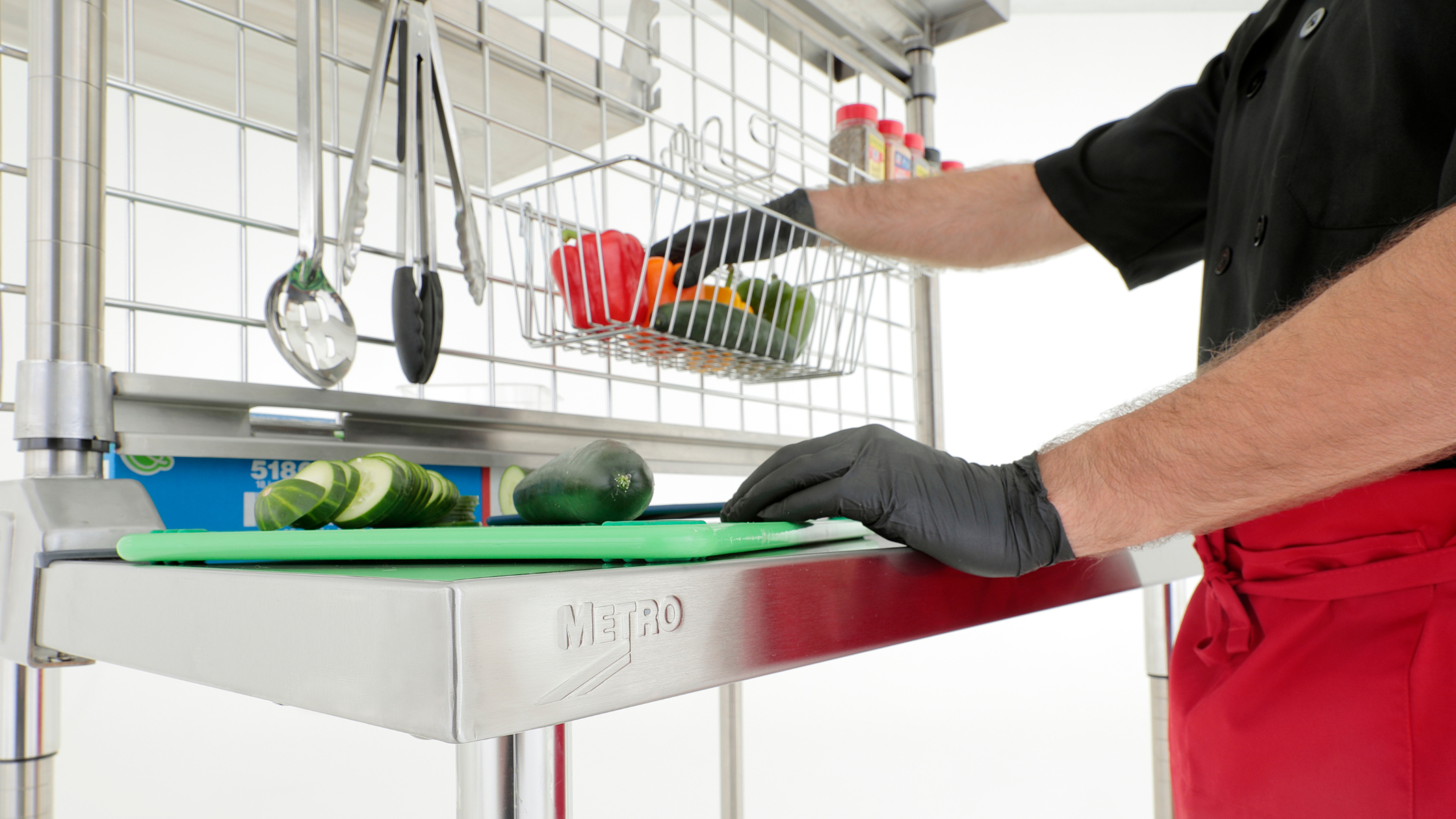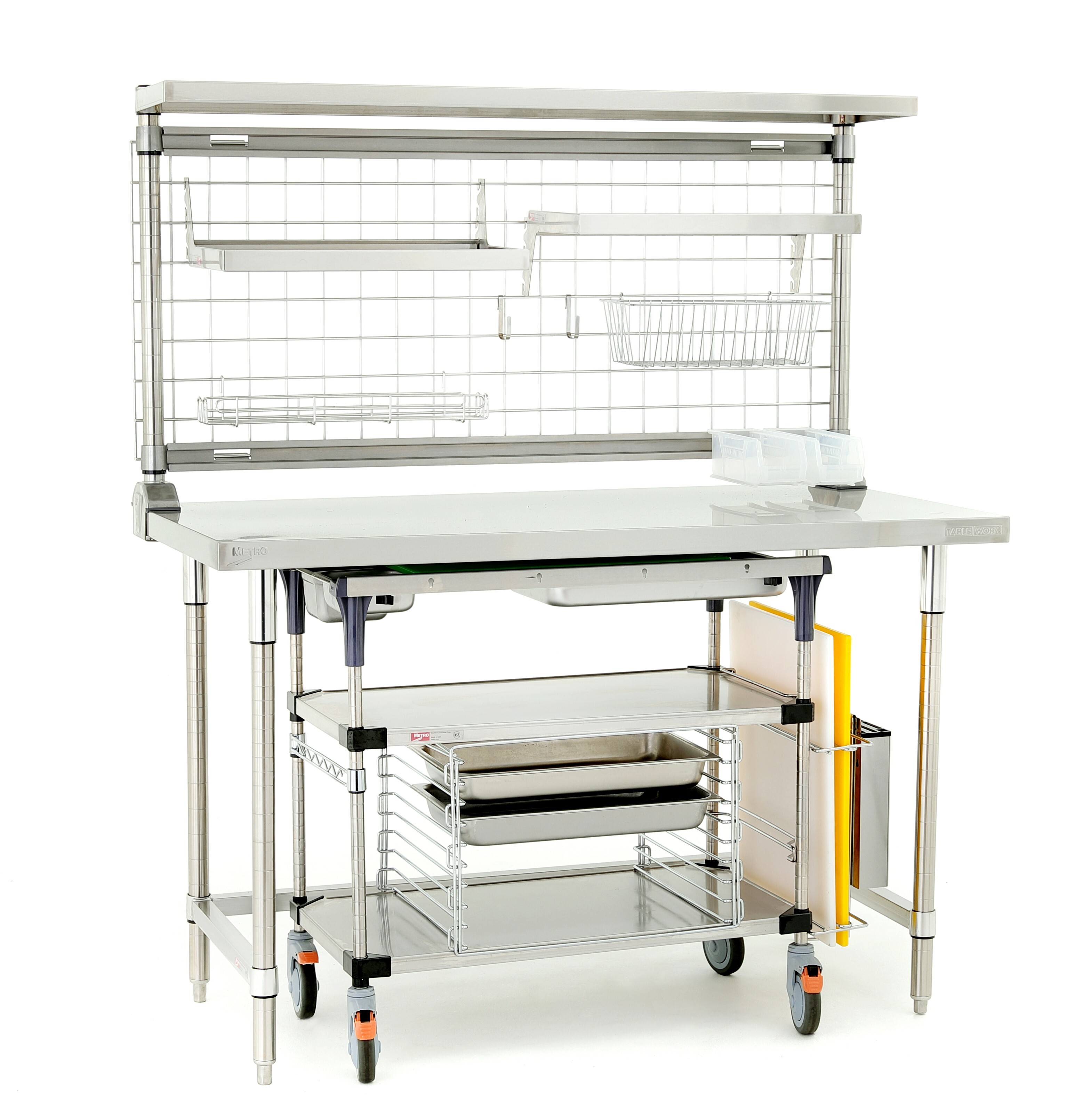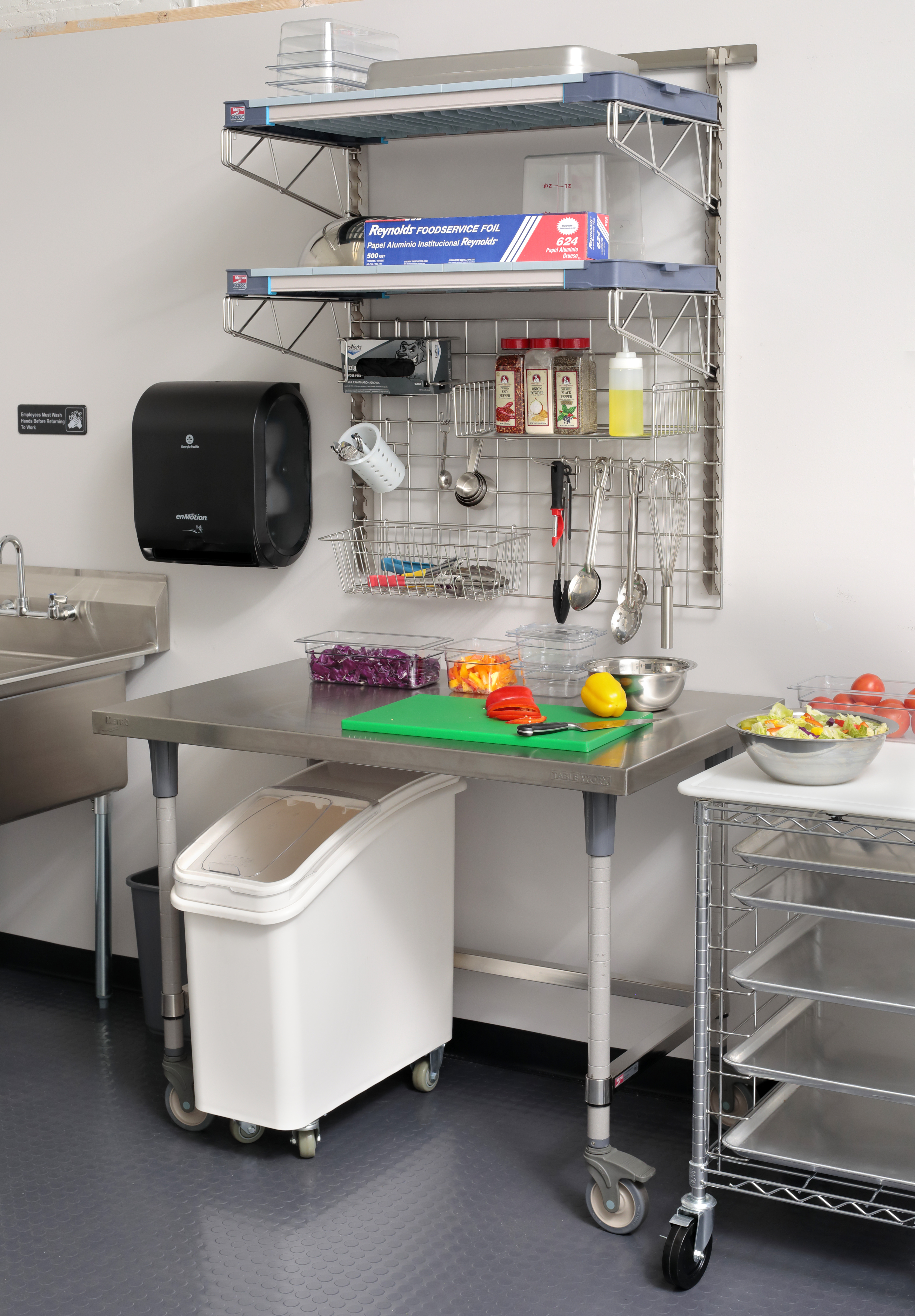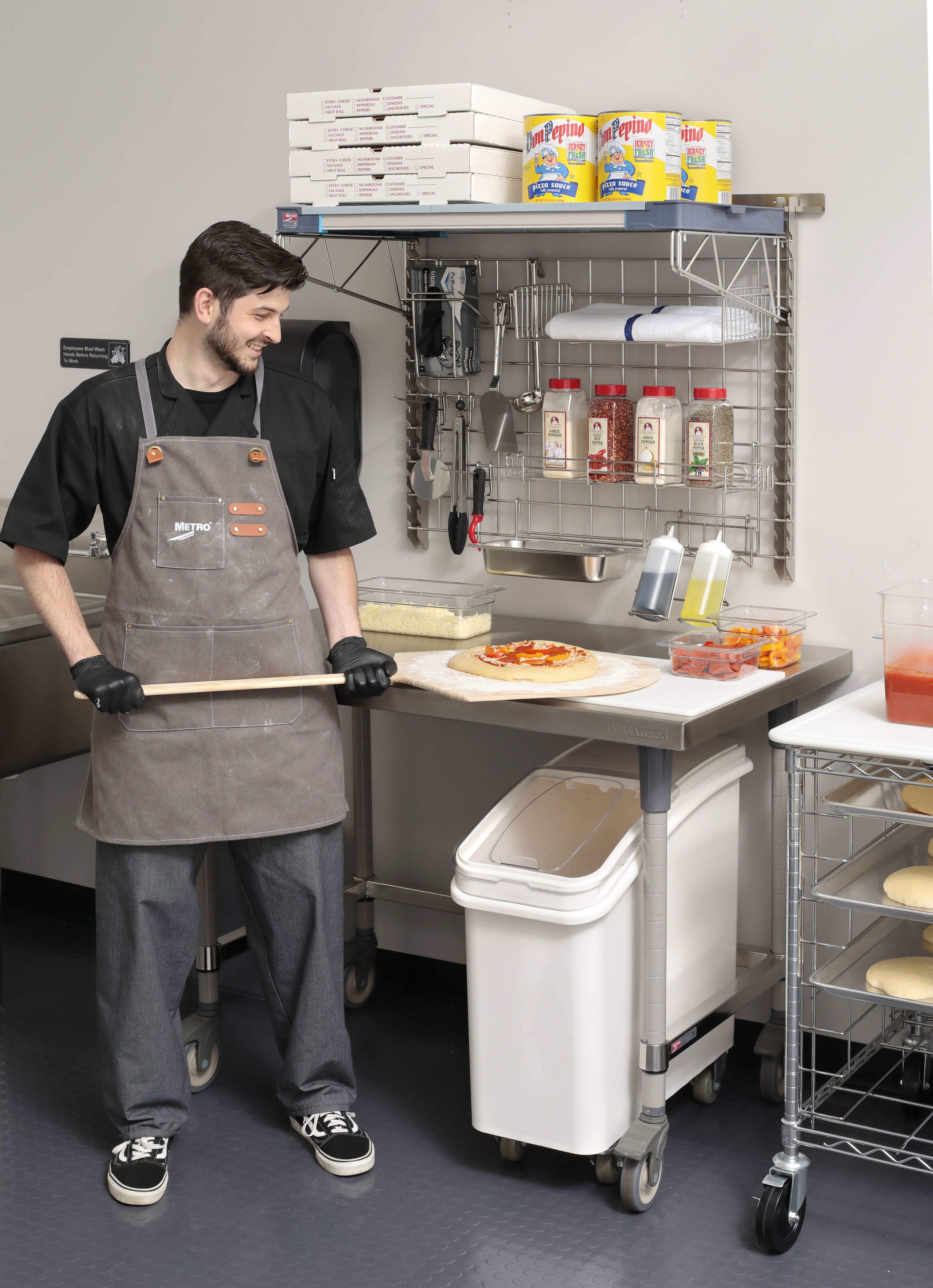Prep tables play a central role in commercial kitchens, supporting everything from ingredient preparation to plating. Because they are such an integral part of daily workflow, durability and material quality are just as important as size and configuration. The right table can improve efficiency, reduce cleanup time, and support food safety standards.
Stainless steel is one of the most preferred materials for food prep tables because it resists corrosion, withstands heavy use, and is easy to sanitize. However, not all stainless steel tables are built the same; material grade, table design, and accessories can significantly impact performance and longevity.
Metro TableWorx stainless steel tables are built to meet the demands of busy commercial kitchens. With a range of configurations and accessories, TableWorx provides the flexibility to create workstations that match your menu, space, and workflow.
Continue reading to learn about the key considerations, including steel grade, table style, and add-on features, that will help you select the best option for your operation.

What Is Stainless Steel?
Stainless steel is a metal made by combining iron with other elements, most importantly chromium. The chromium content creates a thin, invisible layer on the surface that protects the metal from rust and corrosion. This layer is self-healing, meaning that if the surface becomes scratched, it naturally reforms, helping the steel remain strong and clean over time. These qualities make stainless steel one of the most durable and hygienic materials available.
304 vs. 316 Stainless Steel: What’s the Difference?
In the foodservice industry, the most common type of stainless steel is 304, due to its exceptional corrosion resistance, ease of sanitation, high formability, and affordability. However, 316 stainless steel is preferred for some applications due to its superior resistance to chlorides.
- 304 Stainless Steel: Ideal for most foodservice applications. It offers strong corrosion resistance and is suitable for general kitchen use. Contains approximately 18% chromium and 8% nickel.
- 316 Stainless Steel: Best for environments with high acidity, such as pizza prep stations or areas where brines and sauces are common. Contains 16-18% chromium, 10-14% nickel, and 2-3% molybdenum, which adds extra protection against chemical corrosion.
Choosing the right grade ensures your table performs well under the specific conditions of your kitchen. Metro offers prep tables in both 304 and 316 stainless steel options to support long-term durability and food safety.
Learn more about 316 stainless steel.
How Stainless Steel Compares to Other Materials
While stainless steel is widely considered the best surface material for prep tables because it offers unmatched durability, hygiene, and long-term value, it’s not the only option. Here’s how other common materials compare:
Aluminum
Aluminum is lightweight and naturally resistant to corrosion. However, it’s softer than stainless steel and more prone to dents and scratches. It can also react with acidic foods, which may affect taste and safety. For heavy-duty use, aluminum doesn’t offer the same strength or longevity.
Galvanized Steel
Galvanized steel is coated with zinc to help prevent rust. It’s more affordable than stainless steel but less hygienic and more vulnerable to wear. The zinc coating can deteriorate over time, particularly with frequent cleaning or exposure to moisture.
Wood
Wood tables are often used in specialty or artisanal settings, such as pastry work. They are visually appealing, but they’re porous and may require specific cleaning and maintenance. Wood absorbs moisture and odors, which makes it less suitable for high-volume or high-risk foodservice operations.
Plastic (HDPE)
High-density polyethylene (HDPE) tables are lightweight and resistant to chemicals, making them ideal for use in light-duty or temporary setups. However, plastic surfaces can scratch easily, creating crevices where bacteria can hide. They also lack the heat resistance and structural integrity of metal options.
Benefits of Stainless Steel in Foodservice
There are many benefits to using stainless steel prep surfaces in commercial kitchens. Here are three of them:
1. Easy to Clean and Sanitize
Cleanliness is essential in foodservice. Stainless steel is a non-porous material, making it easy to wipe down and disinfect, which reduces the risk of cross-contamination and helps maintain compliance with health codes.
2. Resistant to Corrosion and Wear
Unlike wood or plastic, stainless steel doesn’t absorb moisture or warp. It stands up to spills, heat, and frequent cleaning. That means fewer replacements and less downtime.
3. Long-Term ROI vs. Cheaper Alternatives
304 and 316 stainless steel tables may cost more upfront, but they pay off in the long run. Their durability and low maintenance needs result in fewer replacements and improved hygiene standards.
Building the Perfect Prep Table
When selecting a stainless steel prep table, the structure plays a major role in how well it supports your kitchen’s workflow. Metro TableWorx work tables come in various sizes and configurations, allowing operators to customize their prep stations for efficiency, cleanliness, and durability.

Multiple Base Options
The frame design of a prep table significantly impacts its practical use, particularly in terms of storage, seating, and stability requirements. Metro TableWorx tables are available in several base styles, each suited to different workflows.
I-Frame: Vertical supports at each end leave the front and back open. This provides maximum legroom and under-table access, making it a good choice for seated prep or stations where staff need to move in and out quickly.
3-Sided Frame (also known as open base): Horizontal supports run along the back and both sides, leaving the front open. This adds rigidity and stability for heavier-duty work, while still allowing space in the front for carts, trash cans, or equipment.
Solid Stainless Steel Shelves: Instead of an open frame, a solid undershelf provides storage for pans, small appliances, or dry goods. This keeps supplies organized and within reach while maintaining a clean, durable surface.
3 Styles to Choose From
TableWorx stainless steel prep tables are available in 304, 316, and hybrid options.
Standard: Uses a heavy-gauge 304 stainless steel top, giving you a durable, food-safe work surface that stands up to constant use and cleaning. The posts and mounts are finished in epoxy and polymer, which provide sturdy support while keeping overall cost lower than all-stainless designs.
Type 304 All-Stainless: Made entirely from 304 stainless steel, including the surface, undershelf, posts, and mounts.
Type 316 All-Stainless: Built with a heavy-gauge 316 stainless steel top, optional 316 overshelves, and 304 stainless undershelf and posts.
The standard style is suitable for most foodservice applications; however, 304 and 316 models may be preferred if extra durability and corrosion resistance are required for the entire table.
Mobile vs. Stationary Tables
Metro TableWorx stainless steel work tables are available in both mobile and stationary models.
Mobile prep tables: Casters allow staff to reposition mobile tables as needed. This is especially useful in kitchens where layouts change frequently or where cleaning behind and beneath equipment is a priority. Mobility also supports temporary setups, catering operations, and multi-use spaces.
Stationary tables: Built for stability, stationary prep tables stay in place and provide a solid foundation for high-volume prep work. They are ideal for areas where consistency and strength are more important than flexibility.
When choosing between mobile and stationary options, consider how often the table will need to be moved, how much weight it will support, and whether the space requires frequent deep cleaning.
With or Without Backsplash
A backsplash helps protect walls from splashes, spills, and food debris. It’s especially useful in areas where prep tables are placed against walls or near sinks. Metro offers tables with integrated backsplashes in various heights to suit different applications.
Tables without a backsplash offer a cleaner look and more flexibility in placement. They’re ideal for island-style setups or pass-through stations where access from both sides is needed.
When deciding between these options, consider your kitchen’s layout, cleaning protocols, and the types of tasks performed at each station.
Vertical Space Optimization
In commercial kitchens, space is always at a premium. Every inch matters, especially when it comes to prep areas. Turn a stainless steel table into a well-designed prep station with the addition of a riser system and accessories. The TableWorx system allows kitchens to utilize all available space to support better organization and faster workflows.
Mounting Options: Center, Rear, and Pass-Thru
Metro’s TableWorx system offers several mounting configurations that allow operators to take advantage of vertical space without sacrificing accessibility.
- Center-mount uprights are ideal for island-style setups. They allow access from both sides of the table, making them a good fit for collaborative prep stations or open kitchen designs.
- Rear-mount uprights are positioned at the back of the table. This setup is best for wall-facing stations where tools and supplies need to be within reach but out of the way.
- Pass-thru workstations are designed for high-volume environments where speed and accessibility are key. These configurations allow items to be accessed from either side, which helps streamline handoffs and reduce bottlenecks.
Each mounting style supports a range of accessories that can be customized to fit the needs of the station.

SmartWall Grid and Accessories
The SmartWall grid storage system is a flexible solution for organizing tools, containers, and supplies above the work surface. It keeps essential items within arm’s reach while freeing up valuable counter space. Accessories like hooks, shelves, and bins can be rearranged as needs change, making it easy to adapt the station over time.
This type of vertical integration helps reduce clutter, improve ergonomics, and support faster and more efficient preparation work. It also contributes to better sanitation by keeping tools off the work surface and away from potential sources of contamination.
Stainless Steel Prep Table Applications
Stainless steel prep tables are used across a wide range of foodservice environments. From fast-paced quick-service restaurants to high-volume institutional kitchens, these tables support essential tasks that keep operations running smoothly. Their versatility makes them a foundational piece of equipment in nearly every commercial kitchen.
- General Food Prep: Chopping, mixing, assembling, and plating all require a clean, stable surface. Stainless steel tables provide the durability and hygiene needed for these daily tasks.
- Ingredient Staging: Tables are often used to hold ingredients before they’re cooked or served. This includes raw proteins, produce, sauces, and garnishes.
- Baking Stations: Stainless steel is ideal for rolling dough, portioning pastries, and staging baked goods. Its smooth surface and resistance to heat make it a reliable choice for bakeries and dessert prep areas.
- Cold Prep Areas: In salad stations or sandwich assembly zones, stainless steel tables help maintain cleanliness and resist moisture buildup.
- Cleaning and Sorting: Some tables are used for sorting dishes, prepping cleaning supplies, or organizing utensils and containers.

Use Case Spotlight: Pizza Prep Stations
Pizza prep is a specialized workflow that demands both durability and resistance to acidic ingredients. Tomato sauce, brines, and fermented doughs can be harsh on surfaces, especially over time. That’s why stainless steel is often recommended for pizza stations. It offers enhanced corrosion resistance, making it better suited for environments where acidity is a constant factor.
In a pizza prep setup, tables are typically paired with ingredient bins, cutting boards, and refrigerated drawers. The layout should support a logical flow from dough handling to topping assembly to oven loading. The Metro SmartWall Life Pizza Prep kit is a great addition that can be paired with a TableWorx stainless steel work table to create a durable and efficient stainless steel pizza prep station.
Operators can also benefit from rear-mount or pass-thru configurations, which allow for efficient movement and collaboration during peak service hours. Whether the station is part of a dine-in pizzeria or a high-volume delivery kitchen, the right prep table setup can improve speed, consistency, and food safety.
SmartWall Complete Pizza Prep kits are also available in Metroseal Gray.
Why Choose Metro TableWorx
When selecting a prep table for your kitchen, quality and reliability matter. Metro’s TableWorx line is built to meet the demands of foodservice professionals who need equipment that performs day after day.
Built for Performance
TableWorx tables are constructed with high-grade 304 and 316 stainless steels. This ensures resistance to corrosion, durability under heavy use, and compliance with food safety standards. The design supports a wide range of configurations, allowing operators to tailor their workstations to fit specific workflows and space constraints.
NSF Certification and Compliance
Every TableWorx prep table meets NSF standards for food safety and sanitation. This certification gives operators confidence that their equipment supports a clean and compliant kitchen environment. Whether you're working in a high-volume restaurant or a specialized prep station, NSF compliance helps streamline inspections and maintain operational standards.
Long-Term Value
Investing in a well-built prep table reduces the need for frequent replacements. TableWorx tables are designed to last, which means fewer disruptions, lower maintenance costs, and better return on investment over time. The ability to customize and expand with accessories also adds flexibility, allowing your setup to evolve with your kitchen’s needs.
Finding the Right Prep Table for Your Kitchen
A prep table should support your team’s work, hold up to daily use, and meet the demands of your kitchen. Whether you’re outfitting a new operation or replacing older equipment, the right table can improve efficiency and help maintain a cleaner, more organized workspace.
Start by thinking about how the table will be used. Consider the types of ingredients you handle, the cleaning routines in place, and whether mobility is important. Look at how vertical space might be used and what accessories could help streamline your workflow.
Not sure where to begin?
Metro offers a range of prep table configurations designed to meet the needs of foodservice professionals. If you’re planning a new layout or upgrading your current setup, reach out to your Metro representative or contact us directly. We’re here to help you build a prep station that works for your space, your team, and your goals.
